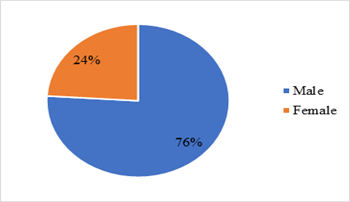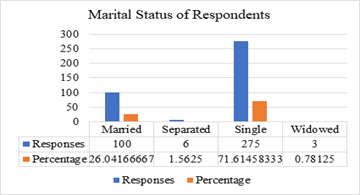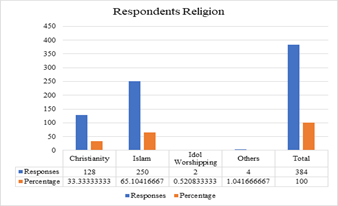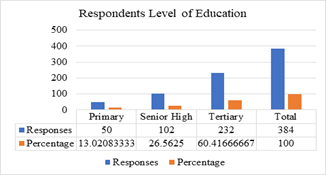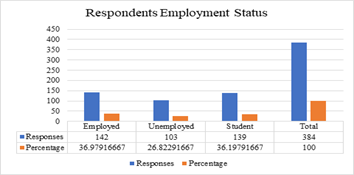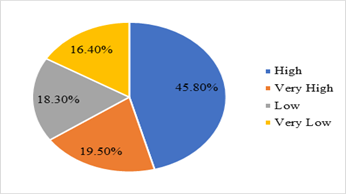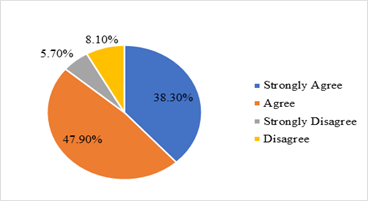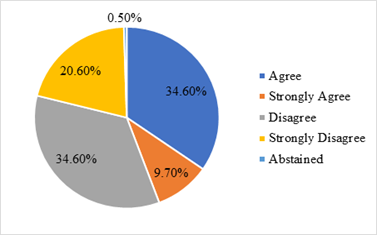Review Article
Awareness About the Health Implications of Energy Drinks and Their Constituent Ingredients Among Consumers in Zongo Communities
- Abdulraheem Mohammed *
Texila American University, Islamic Nursing Training School, Ghana.
*Corresponding Author: Abdulraheem Mohammed, Texila American University, Islamic Nursing Training School, Ghana.
Citation: Abdulraheem Mohammed. (2024). Awareness About the Health Implications of Energy Drinks and Their Constituent Ingredients Among Consumers in Zongo Communities. Scientific Research and Reports, BioRes Scientia Publishers. 1(2):1-11. DOI: 10.59657/2996-8550.brs.24.010
Copyright: © 2024 Abdulraheem Mohammed, this is an open-access article distributed under the terms of the Creative Commons Attribution License, which permits unrestricted use, distribution, and reproduction in any medium, provided the original author and source are credited.
Received: April 06, 2024 | Accepted: April 23, 2024 | Published: April 30, 2024
Abstract
There is a low level of awareness of the health implications of energy drinks among consumers in Zongo communities in Ghana. Coupled with that, consumers are unaware of the constituent ingredients that are used for manufacturing energy drinks. The alarming spike in the consumption of these products is a concern for public health, for which drastic measures needs to be taken to minimize the health problems that consumers may face if they do not exercise the necessary precautionary measures.
Keywords: health implications; energy drinks; constituent ingredients; consumers; zongo communities
Introduction
Enriched with ingredients and coupled with exaggerated supposed benefits which are in sharp contrast with other sugar sweetened beverages, Energy Drinks have been described by many as sugary, non-carbonated beverages that contain added sugars, minerals and electrolytes that are specially manufactured to help replenish the body's energy (Daradkeh, et al., 2018). They are widely known as stimulants enriched drinks that may or may not contain sugar, and have been approved by regulating authorities as soft drinks that are safe for consumption (Alsunni, 2015).
It is believed that energy drinks provide relief to or prevent fatigue, enhance physical performance, cognitive performance and disposition (Buxton & Hagan, 2012). Featured by the addition of a variety of energy-enhancing ingredients to increase energy, reduce fatigue, and improve mental alertness and focus (Friis, et al., 2014), energy drinks consumption has witnessed a dramatic increase in the past two decades (Alsunni, 2015). As the escalating rate of energy drinks consumption has become a global public health issue of concern (Saku, et al., 2020), there has been a continuous increase in brands of energy drinks in Ghana, which may be due to a booming market that has called on different industry players to take advantage of the market (Helix Strategy, 2021). The wide acceptability of energy drinks across social, cultural, economic, religious and educational backgrounds in the Ghanaian society is dramatically evident (Nti, Pecku & Opsre-Obisaw, 2022).
Despite limited knowledge about the constituent ingredients in energy drinks among consumers, the state of energy drinks consumption is increasing throughout the world (Mohammed, et al., 2022). According to Higgins, Tuttle and Higgins (2010), the main ingredients in energy drinks that are predominantly consumed by the public for alertness, boosting performance and reliving stress contain psychoactive substances such as caffeine, guarana, taurine, ginseng, and other complementary substances such as milk thistle, vitamin B, ginkgo biloba, and L-carnitine.
Preponderant scientific studies have indicated that knowledge about the constituent ingredients in energy drinks among consumers have demonstrated to be very low and evidencing poor attention to precautionary and safety measures that have to be habituated (Al-Taie & Arueyingho, 2022).
Even though energy drinks serve as important materials in enhancing performance and productivity among workers in various capacities and industries, it is important to acknowledge the detrimental effects that they have on human health such as arterial dilatation, aneurysm formation, arterial fibrillation, dissection and rapture of large vessels, inexhaustibility, muscle twitching, restlessness, violent behavior, conduct disorders, ischemic stroke, seizures, obesity, reduction in insulin capacity which leads type II diabetes mellitus, diuresis, natruiresis (increased loss of sodium in urine), dental caries and erosions (Alsunni, 2015).
Problem Statement
Even though energy drinks by law are non-narcotic products, they have the potential to affect human health negatively if caution is not applied in how they are consumed. The increasing attraction to and consumption of energy drinks in Zongo communities is becoming worrisome, and the trend is not showing any downturn. There are various brands of energy drinks that consumers patronize on daily basis for different purposes. Awareness of the health implications of energy drinks by consumers needs to be known, and their awareness of the constituent ingredients in energy drinks also needs to be established to ascertain what is known and unknown for public health experts to know what strategies to use to safeguard the health of the populace.
Hypothesis
H1: Ghanaian energy drink consumers in Zongo communities are to a large extent unaware of the health implications of energy drinks.
H1: Energy drinks consumers in Zongo communities are unaware of the constituent ingredients in energy drinks.
Significance of the study
This study provides insights into what consumers of energy drinks in Zongo communities are aware of about the health effects of energy drinks. Identifying the level of awareness about the health implications of energy drinks consumption as well as awareness about the constituent ingredients in these drinks among members of the population can help public health institutions to identify what measures needs to be instituted to safeguard the health of the public against the brutal health problems that energy drinks may propound.
Literature Review
Scientific evidences are growing in their numbers to indicate that energy drinks are not safe for human health even though they provide an easy route to ward off tiredness and to enhance physical activity and alertness (National center for Complementary and Alternative Health, 2018). A lot of people frequently consume energy drinks because they consider it as a mere soft drink (Musaiger & Zagzoog, 2013) that has no negative effect on health. The frequent consumption of these drinks contributes immensely to low psychological, physical, educational and overall wellbeing (Khouja, et al., 2022). When consumed in high amounts, energy drinks can increase the risk of developing neurological disorders that may present either as anxiety, hyperactivity, or insomnia, cardiovascular related conditions like arrhythmias and hypertension, digestive system malfunctions and also dehydration (Saku, et al., 2020; National center for Complementary and Alternative Health, 2018).
Even though energy drinks serve as important materials in enhancing performance and productivity among workers in various capacities and industries, it is important to acknowledge the detrimental effects that they have on human health such as arterial dilatation, aneurysm formation, arterial fibrillation, dissection and rapture of large vessels, inexhaustibility, muscle twitching, restlessness, violent behavior, conduct disorders, ischemic stroke, seizures, obesity, reduction in insulin capacity which leads type II diabetes mellitus, diuresis, natruiresis (increased loss of sodium in urine), dental caries and erosions (Alsunni, 2015). Anatomy and Physiology wise, young adolescents have very good structural and functional compositions that make their bodies withstand the harmful effects of many substances. Despite these qualities, a study conducted in Saudi Arabia evidenced increased palpitations, diuresis and insomnia among populations of young adolescents that consumed energy drinks (Subaiea, Altebainawi, & Alshammari, 2019). Additionally, osteoporosis, poor dietary behavior, peptic ulcer disease, calcium deficiency, reduced bone density, poor growth and development, and fertility related abnormalities are a pool of negative effects that are associated with the intake of caffeine enriched products like energy drinks (Kim, 2018).
Despite limited knowledge about the constituent ingredients in energy drinks among consumers, the state of energy drinks consumption is increasing throughout the world (Mohammed, et al., 2022). According to Higgins, Tuttle and Higgins (2010), the main ingredients in energy drinks that are predominantly consumed by the public for alertness, boosting performance and reliving stress contain psychoactive substances such as caffeine, guarana, taurine, ginseng, and other complementary substances such as milk thistle, vitamin B, ginkgo biloba, and L-carnitine.
Preponderant scientific studies have indicated that knowledge about the constituent ingredients in energy drinks among consumers have demonstrated to be very low and evidencing poor attention to precautionary and safety measures that have to be habituated (Al-Taie & Arueyingho, 2022). One of such is the study by Rahmatullah (2017) among Saudi Arabia university students, where majority of the study participants demonstrated that they had poor knowledge of the ingredients in energy drinks and why energy drinks must not be consumed during pregnancy. Even though it is presumed to be widely known that caffeine is the main ingredient in energy drinks, a significant percentage of study respondents in a Myanmar investigation about the state of awareness about the constituent ingredients in energy drinks revealed that the respondents had no insight about the availability of caffeine in energy drinks (Oo, Phyo & Win, 2020).
A study in Slovenia however points to that, secondary school students who have habituated the consumption of energy drinks are more aware of the constituent ingredients in them than those in elementary schools who are also fond of consuming them (Lorenzi, Kovac & Koch, 2021). Costa, Hayley & Miller (2014) have averred that despite familiarity with common energy drinks and frequent use, the lack of knowledge about the ingredients is them among consumers is very disturbing and coupled with the inability by consumers to decipher whether energy drinks are soft or sports drinks. Evidently, there is a very high state of misconception and lack of awareness about the ingredients domiciled in energy drinks (Al-Taie & Arueyingho, 2022). Surprisingly, knowledge about the ingredients in energy drinks among medical students is significantly low (Hidiroglu, et al., 2013).
Methods
Population of the Study
The population of this study included all males and females from the age of 16 years and above within two zongo communities (Nima and Mamobi) who consume energy drinks. Since the research topic is focused on knowing the state of awareness of the health implications of energy drinks among consumers, as well as their level of awareness about the constituent ingredients in energy drinks, the best subjects that can be approached for the collection of data that can be analysed to elicit the needed results are energy drinks consumers themselves. The study used the 2021 Ghana population and housing census report of the population of people from the age of 16 years and above in both Nima and Mamobi as the population for this study. According to the 2021 census report, Ayawaso East, which houses Nima has a population of 38,338 people who are in the age range of 16 years and above. While Ayawaso North which houses Mamobi has a population of 46,075 people who are within the same age bracket. A mathematical summation from both jurisdictions gives a total population of 84,413 who are within the age bracket.
Sample Size
The sample size for this study included 384 subject respondents who consumes or consumed energy drinks within the past six months of the collection of data.
Sampling Technique
A multistage sampling technique was used for this study. In this regard, a total of 192 respondents were assigned to Mamobi and same was assigned to Nima. Each suburb was divided into 10 clusters which included Homes, Shops, Market, Okada Riders’ Station, Lorry Parks, Mechanic Shops, Smokers’ Joints, Washing Bays, Churches, Mosques, Offices and Schools. A minimum of nineteen questionnaires were administered to respondents in each of the clusters of each of the study settings.
Data Collection Instrument
Self-administered questionnaire that was developed by the principal investigator containing closed-ended questions and rating scales was used in the collection of data for the study.
Data Collection Procedure
Four research assistants who hold bachelor’s degree in different fields were recruited and trained by the principal investigator on how to collect data from eligible respondents for the study. They were first given explanation about what the study entails and what information were of significance to the study. They then were taken through all the needed steps they have to take to ensure that they get and obtain consent from the right respondents for the study. Detailed education on the contents of the questionnaire was also ensured. This was done by taking them through the exact meanings of every question and what form of statements they can use in Twi, Ga, Hausa or English to help respondents understand the questions better. They were then engaged in a pilot study in Accra New Town to ensure that they understood what is required of them. The pilot study was also used to test clarity and reliability of the questionnaire. The training took a period of one week to complete.
Respondents were then approached by either the principal investigator or the research assistants, where they identified themselves and explained the purpose of the research to the respondents. Consent forms were given to respondents to sign and were assured of their privacy and confidentiality. Minors who participated in the study had their consent given by their parents/guardians without any form of coercion. All subjects were assured of their anonymity and their right to withdraw from the study at any stage.
Ethical Considerations
Texila American University granted approval to carry out the study. Respondents were assured of their privacy and the confidentiality of their responses. They were also assured of their right to withdraw their consent from participating in the study at any point. They were further assured that their decision will always be respected and granted by the researcher. Subsequently, consent forms were given to respondents to append their signatures of authorization, sequel to which they were given the questionnaire containing closed ended and rating scale questions to fill and return to the researcher or any of his assistants. In instances where respondents were minors, their parents/guardians were approached. The purpose of the study and contents of the questionnaires were thoroughly explained to them. They were assured of the anonymity and the confidentiality of the identity of the minors as well as their responses in the study. Such parents/guardians signed on behalf of the minors to give consent. The minors as well as their parents/guardians were informed of their right to withdraw from the study at any stage of the study.
Data analysis
Three hundred and eighty-four questionnaires were distributed among consumers of energy drinks in the research settings, and all the three hundred and eighty-four questionnaires were retrieved. Microsoft Office Excel 2013 and VBA (Visual Basic for Application) were used for data entry processing of data collected and The R programing language tool was used for data visualization and analysis.
Age range of Respondents
Table 1: Age Group Breakdown
| Age range | Respondents | Percentage (%) |
| 11-15 years | 24 | 6.25 |
| 16-20 years | 78 | 20.31 |
| 21-25 years | 101 | 26.30 |
| 26-30 years | 63 | 16.41 |
| 31-35 years | 39 | 10.16 |
| 36-40 years | 38 | 9.90 |
| 41-45 years | 16 | 4.17 |
| 46-50 years | 16 | 4.17 |
| 51-55 years | 5 | 1.30 |
| 60 years and above | 4 | 1.04 |
| Total | 384 | 100 |
Table 1 above shows the age range of the respondents who participated in the study. Of the total number of respondents, 24 of them representing 6.25% were within the age range of 11 – 15 years, 78 of them representing 20.31% were within the age range of 16-20 years, 101 of them representing 26.30% were within the age arrange of 21 – 25 years, 63 of them representing 16.41% were within the age range of 26 – 30 years, 39 of them representing 10.16% were within the age range of 31 – 35 years, 38 of them representing 9.90% were within the age range of 36 – 40 years, 16 of them representing 4.17% were within the age range of 41 – 45 years, 16 of them representing 4.17% were within the age range of 46 – 50 years, 5 of them representing 1.30% were within the age range of 51 -55 years and 4 of them representing 1.04% were within the age range of 60 years and above.
The differing percentages in the table is a clear indication that the allocation of questionnaires to the various age groups was not influenced by any form of bias. This informs the impartiality of the researcher in the distribution of questionnaires.
Sex
Figure 1: Sex of Respondents
The above pie chart (Figure 1) shows the age distribution of the respondents who participated in the study. The female respondents constituted 24% of the total number of respondents, while the male respondents constituted 76%. This indicates that there were more males who voluntarily consented to taking part in the study than females.
Marital Status
Figure 2: Respondents’ Marital Status
The above chart (Figure 2) shows the marital status of the respondents who participated in the study. It can be clearly seen that, three of them were widowed, two-hundred and seventy-five were separated with their spouses, one-hundred of them were married, and six of them were single (not married). This indicates that the number of unmarried respondents in this study were higher than those who were married, and those who were married were more than those who were separated and widowed.
Religion
Figure 3: Respondents Religion
The chart (figure 3) above shows the religious affiliation of the respondents who participated in the study. It can be seen that 128 of them were Christians, 2 of them were idol worshipers, 250 of them were Muslims and 4 of them belonged to other faiths. This is shows that Muslims were the largest respondents who participated in this study, and this is followed by Christians.
Level of Education
Figure 4: Respondents Level of Education
The chart (Figure 4) above shows the educational attainment of the respondents who participated in the study. Fifty of them have primary education, one-hundred and two have secondary education, while two-hundred and thirty-two have tertiary education. This therefore suggest that each respondent within the study has basic level education, which is a constitutional right in Ghana.
Employment Status
Figure 5: Employment Status of Respondents
The chart (Figure 5) above shows the employment status of the respondents in the study. One-hundred and three of the respondents indicated that they were not gainfully employed. One-hundred and forty-two were employed, while one-hundred and thirty-nine indicated that they were students who were still in school and depend on their parents or guardians for their upkeep.
What motivated you to consume your first energy drink?
Table 2: Motivating factor for first energy drink experience
| Variable | Respondents | Percentage (%) |
| Nothing at all | 161 | 41.93 |
| Friends/peer pressure | 79 | 23.24 |
| Media advert | 60 | 15.63 |
| Curiosity | 50 | 13.02 |
| Media advert Curiosity | 14 | 3.64 |
| Friends/peer pressure Media advert | 12 | 3.13 |
| Curiosity Friends/peer pressure | 7 | 1.82 |
| Friends/peer pressure Media advert Curiosity | 3 | 0.78 |
| TOTAL | 384 | 100 |
Table 2 above shows respondents responses about what motivated them to consume their first ever energy drink. One hundred and sixty-one of them indicated that nothing at all motivated them to consume their first ever energy drink. Seventy-nine respondents indicated that friends/peer pressure were the main driving force(s) that made them to consume their first ever energy drink. sixty respondents indicated that media adverts were the main factor that motivated them to consume their first ever energy drink. Fifty respondents indicated that curiosity was the main motivating factor that made them consume their first ever energy drink. Fourteen said that friends/peer pressure as well as media advert were the main factors that motivated them to consume energy drinks. It is also clear from the table (Table 2), that 12 out of the total number of the respondents indicated that media adverts and curiosity were the main factors that motivated them to consume their first ever energy drink. Seven of the respondents indicated that curiosity and friends/peer pressure were the motivating factors that made them to consume their first ever energy drink. Finally, three respondents indicated that friends/peer pressure, media advert and curiosity were the factors that motivated them to consume their first ever energy drink. It is clear from this data that a single factor or a multiplicity of factors can influence a person to consume their first ever energy drink.
Which of these brands of energy drinks are you fond of drinking?
Table 3: Brands of Energy Drinks that Respondents usually consume
| Variable | Respondents | Percentage (%) |
| Consumption of 1 Brand only | 144 | 37.5 |
| Consumption of 2 different Brands | 134 | 35% |
| Consumption of 3 different Brands | 63 | 16.4 |
| Consumption of 4 or more different Brands | 40 | 10.4 |
| Consume others | 3 | 0.7 |
| TOTAL | 384 | 100 |
Table 3 above shows respondents responses about the brands of energy drinks that they are fond of drinking. The energy drinks commonly consumed in the population include, Storm, Run, 5-star, Rush, Red Bull, Lucozade Boost, Adonkoo Next Level, Kabisa, V+8 energy, and others. From the data in Table 3, it can be noted that about 37.5% of the respondents are fond of consuming at least one brand of energy drink, 35% are fond of consuming at least two brands of energy drinks, 16.4% are fond of consuming at least three different brands of energy drinks, about 10.4% are fond of consuming more than three different brands of energy drinks, and 0.7% of them are fond of drinking some other energy drinks that were not captured in the questionnaire. It can therefore be established that majority of consumers of energy drinks in the population are fond of consuming more than one energy drink. Every energy drink has the potential of being patronized in the population irrespective of constituent ingredients and health implications.
How frequent do you consume energy drinks?
Table 4: Respondents’ frequency of Energy Drinks Consumption
| Frequency | Respondents | Percentage (%) |
| Irregular/Unusual | 148 | 38.54 |
| At least 1 bottle per day | 135 | 35.16 |
| More than 1 bottle 2 to 3 times a week | 41 | 10.68 |
| More than one bottle per day | 32 | 8.33 |
| More than 1 bottle 4 to 7 times a week | 28 | 7.29 |
| TOTAL | 384 | 100 |
Table 4 above shows how frequent respondents consume energy drinks. One hundred and fourty-eight respondents, representing 38.54% of the study participants indicated that their mode of consuming energy drinks can be described as irregular or unusual. This suggests that the population has a 38.54% of energy drinks consumers whose behaviour towards energy drinks consumption can be described as irregular or unusual. One hundred and thirty-five respondents representing 35.16% of the respondents indicated that they consume at least one bottle every day of the week. Forty-one of the respondents, representing 10.68% of the study participants indicated that they consume more than one bottle two to three times every week. This means that within the population some significant number of energy drinks consumers consume about four or more bottles every week. Thirty-two of the respondents representing 8.33% indicated that they consume more than one bottle per day. In essence, 8.33% of the respondents consume two or more bottles every day of the week. Twenty-eight of them, representing 7.29% of the study participants indicated that they consume more than one bottle, four to seven times a week. This is suggestive that some respondents consume about eight to 14 bottles of energy drinks or even more every week.
Why do you consume energy drinks?
Table 5: Respondents’ reasons for consuming Energy Drinks
| Variable | Population | Percentage (%) |
| Only 1 reason for consuming energy drinks | 245 | 63.80 |
| Only two reasons for consuming energy drinks | 43 | 11.20 |
| Consumes energy drinks based on 3 or more reasons | 65 | 16.93 |
| No reason | 30 | 7.81 |
| No response | 1 | 0.26 |
| TOTAL | 384 | 100 |
The table (Table 5) above shows the summary of how the respondents responded on why they consume energy drinks. The reasons for which energy drinks is consumed as was highlighted in the questionnaire included, to give company to friends, to remain awake and alert, for more energy and vitality, nice taste, for better performance in driving, for better sex performance, for better performance in sports/gym, for better performance in examinations, fantasy, to quench thirst, as a favorite drink, to alleviate tiredness, to be able to dance at parties, to complete tasks, to counter hypoglycemia, to prevent dehydration and no reason at all. It can be deduced from the data that 7.81% of the respondents consume energy drinks for no absolute reason, 63.80% of them consume energy drinks for at least one reason, 11.20% of the them consume energy drinks for at least two reasons and 16.93% of them consume energy drinks for at least, three or more reasons.
Which of these benefits do you derive from consuming energy drinks?
Table 7: Benefits derived from energy drinks.
| Variable | Population | Percentage (%) |
| At least 1 benefit | 183 | 48 |
| 2 benefits | 97 | 25 |
| 3 benefits | 79 | 20 |
| 4 or more benefits | 22 | 6 |
| No response | 3 | 1 |
| TOTAL | 384 | 100 |
The above table (Table 7) shows respondents responses when they were asked about the kind of benefits they derive whenever they consume energy drinks. The benefits on the questionnaire to which the respondents were to respond to included, ability to stay awake longer, increased work performance, improved mental performance, increased alertness, Increased power in sport/ exercise, increased mental alertness, improved digestion, replacement of body fluids, increase blood sugar, improved rehydration, less tiredness, increased fun with friends, improved sexual performance. Analytically, about fourty-eight percent of the respondents who consume energy drinks in Nima and Mamobi consume energy drinks because it aids them in achieving at least one specific benefit. Twenty-five percent of them indicated that they consume energy drinks due to at least two different benefits that they accrue from them. Twenty percent of them indicated that they consume energy drinks to derive at least 3 benefits from them. six percent of them indicated that they consume energy drinks to reap 4 or more benefits from them, and only one percent of them declined to indicate any benefit they derive from consuming energy drinks. This results from the respondents suggests that, a vast majority of the population of energy drinks consumers consume energy drinks for one or more perceived benefits that are derivable from consuming them.
Which of these adverse health effects of energy drinks are you aware of?
Table 8: Respondents’ awareness of adverse health effects of energy drinks
| Variable | Respondents | Percentage (%) |
| Awareness of only 1 adverse effect | 160 | 41.67 |
| Awareness of 2 adverse effects | 126 | 32.81 |
| Awareness of 3 adverse effects | 59 | 15.36 |
| Awareness of 4 or more adverse effects | 36 | 9.38 |
| No response | 3 | 0.78 |
| TOTAL | 384 | 100 |
The above table (Table 8) shows respondents responses about the adverse health effects of energy drinks that they are aware are of. The side effects to which respondents responded to from the questionnaire include, increased urination, electrolyte imbalance, abnormal heart beat, increased blood pressure, hardening of blood vessels, peptic ulcer disease, kidney disease, liver disease, dependence, abdominal cramps, insomnia (difficulty in sleeping), headache, confusion, poor vision (sight), seizures (epilepsy), nausea, poor appetite, muscle cramps, decreased performance and dehydration. Instructive from the data is that although there are many adverse health effects associated with energy drinks, majority of consumers are unaware of them. This is because, respondents’ responses shows that 41.67% of the respondents are aware of at least only one adverse health effect of energy drinks, 32.81% of the respondents are aware of at least two adverse effects, 15.36% are aware of at least three adverse effects, and only 9.38% of the respondents are aware of four or more adverse effects of energy drinks. This finding indicates that awareness of the adverse effects of energy drinks among consumers in Nima and Mamobi is very low.
Which ingredients are you aware are available in energy drinks?
Table 9: Respondents’ awareness of the ingredients that are present in energy drinks.
| Variable | Population | Percentage (%) |
| Awareness of at least 1 ingredient | 206 | 53.65 |
| Awareness of at least 2 ingredients | 96 | 25 |
| Awareness of at least 3 ingredients | 31 | 8.07 |
| Awareness of at least 4 or more ingredients | 33 | 8.59 |
| Not aware of any ingredient | 18 | 4.69 |
| TOTAL | 384 | 100 |
The above table (Table 9) shows respondents awareness of the ingredients that are used in the manufacture of energy drinks. The ingredients available on the questionnaire to which respondents answered to included Caffeine, Taurine, Methylxanthines, Ginseng, Guarana, Yerba Mate, Acai, Maltodextrin, Inositol, Carnitine, Creatine, Glucuronolactone, Ginkgo Biloba, Vitamin B and Ginger. Careful observation and analysis of the answers that were provided by the respondents indicated that 53.65% of the entire population of energy drinks consumers in the study settings were aware of only one ingredient in energy drinks, 25% of them were aware of at least only two ingredients, 8.07% of them were aware of at least three different ingredients, 8.59% of them were aware of 4 or more different ingredients, 4.69% of them were not aware of any ingredient in energy drinks.
How would you rate your level of awareness about the health effects of the ingredients in energy drinks?
Respondents Rating of their Awareness of the Health Effects of Energy Drinks
Figure 6: Respondents’ rating of their awareness of the health effects of energy drinks.
The chart (Figure 6) above shows respondents rating of their individual level of awareness of the health effects of energy drinks. A proportionate 45.80% claimed that they can rate their level of awareness of the health effects of energy drinks as high, 19.50% claimed that they can rate their level of awareness about the health effects of energy drinks as very high, 18.30% of them claimed that they can rate their level of awareness about the health effects of energy drinks as low, and 16.40% claimed that they can rate their level of awareness as very low.
Energy drinks have both positive and negative health effects
Respondents Level of Agreement with Energy Drinks having Both Positive and Negative Health Effects
Figure 7: Respondents’ agreement with energy drinks having positive and negative health effects.
The above chart (Figure 7) indicates the responses of respondents on a rating scale about whether they are aware that energy drinks have both positive and negative health effects. As can be seen in the pie chart, 38.30% of the population indicated that they strongly agree with the assertion that the positive health effects associated with energy drinks consumption far outweighs the negative health effects. A preponderant percentage (47.90%) of the population however, indicated that they agree with this assertion but not strongly, 5.70% indicated that they strongly disagree with this assertion, and 8.10% indicated that they disagree with this assertion but not in very strong terms.
The Health Benefits of Energy Drinks are Higher than the Negative Health Effects
Figure 8: Respondents Level of Agreement with the Positive health effects exceeds the Negative Health Effects
The chart (Figure 8) above shows respondents’ perception about whether the health benefits of energy drinks far outweigh the negative health effects associated with their consumption. A significant percentage (34.60%) of the population indicated that they agree that the health benefits of energy drinks are higher than the negative health effects, 9.70% said that they strongly agree with this assertion, 34.60% said that they disagree with this assertion, another proportionate 20.60% said that they strongly disagree with this assertion, and 0.50% of them refrained from providing any answer.
Which of these diseases are you aware can be caused by long term consumption of energy drinks?
Table 10: Respondents’ awareness of diseases that can be caused by long-term consumption of energy drinks
| Variable | Respondents | Percentage (%) |
| 1 disease | 187 | 48.7 |
| 2 diseases | 150 | 39.06 |
| 3 diseases | 27 | 7.03 |
| 4 or more diseases | 17 | 4.43 |
| No response | 3 | 0.78 |
| TOTAL | 384 | 100 |
The above table (Table 10) shows respondent responses when they were asked about the diseases that they are aware may result as an outcome of habitual use of energy drinks. Available diseases on the questionnaire included, hypertension, kidney failure, liver failure, heart failure, seizures (epilepsy) and dependence. The analysis of responses indicated that 48.70% of the respondents were aware of only one disease that can be precipitated by long-term consumption of energy drinks, 39.06% of them were aware of only two diseases that a person may develop as a result of long-term use of energy drinks, 7.03% of them indicated that they are aware of only 3 diseases that may arise as a result of long-term use of energy drinks, and only 4.43% of them indicated that they were aware of 4 or more diseases that may arise as a result of long-term consumption of energy drinks. In essence, the awareness about the diseases that a person may suffer from habituating the use of energy drinks among consumers is low.
Summary
As a non-narcotic product in the Ghanaian market that contains stimulants that increase mental performance, energy drinks are largely consumed by Ghanaians in very high quantities (Saku, et al., 2020; Buxton & Hagan, 2012). They have been approved for sale and safe consumption to the general public by regulatory authorities of many countries (Alsunni, 2015). Despite the wide approval by many countries due to perceived safety, morbidity and mortality cases resulting from energy drinks is rising (Kaur, et al., 2022). Many institutions have begun to tighten regulations regarding their sale to the general public in the interest of public health protection (Energy Drinks Europe, 2022).
There are several factors that motivate people to consume their first ever energy drink in the population. These include friends/peers, media adverts and curiosity. This result from this study is similar to the findings of Hasan, et al., (2020) who indicated that curiosity of taste, recommendation by friends, media advertisement, family influence and the appealing branding are the factors that encourage students to consume their very first energy drink. Chang, et al., (2017) have also documented that curiosity among others are motivating factors for the consumption of energy drinks among populations.
There are various brands of energy drinks in the study settings that consumers patronise. Many of the consumers in the population are fond of consuming more than one brand of energy drink. This is not in contrast with the study by Buxton and Hagan (2012) who espoused that different types of energy drinks are consumed by drinkers. The data also shows that Storm energy drink is the most widely consumed energy drink among the population.
The frequency of consumption by a majority of the population can be described as irregular. However, a significant proportion of the population consume between a minimum of one bottle every day to more than one bottle in day, 4 to 7 times on a weekly basis. Buxton and Hagan (2012) indicated that sport athletes usually consume more than one bottle of energy drinks in a day for improved performance. Saku, et al., (2020) also revealed that commercial drivers consume about 7 to 10 bottles of energy drinks every week.
Even though other healthy and even cost-saving strategies can be used to obtain some of the many reasons for which members of the Zongo communities consume energy drinks, it can be said that they prefer to use energy drinks than to use or explore these other safe strategies. This finding is supported by Saku, et al., (2020) who’s findings revealed that several reasons are responsible for why drivers in the Ho Municipality consume energy drinks, without recourse to the health risks associated with them.
The study further reveals that the benefits derivable from energy drinks which are in most cases short-lived are propelling forces that motivates people to not consider rejecting their consumption, even though the long-term negative effects that these products may have on their health are brutal. These perceived benefits that are usually short-lived include but not limited to, to give company to friends, to remain awake and alert, for more energy and vitality, nice taste, better performance in driving, better sex performance, better performance in sports/gym, better performance in examinations, fantasy, quench thirst, as a favourite drink, to alleviate tiredness, to be able to dance at parties, to complete tasks, to counter hypoglycemia, and to prevent dehydration.
The state of awareness about the adverse effects of energy drinks among consumers in the Zongo communities is very low. Khan, et al., (2017) revealed that, although most consumers of energy drinks opine that energy drinks may expose them to serious health risks, a considerate number of consumers however are unaware of the unwavering health risks that are associated with their consumption. This finding is in alignment with the finding by Khan (2019), who indicated that, even though there exist an increasingly alarming behaviour in the consumption of energy drinks among consumers, there is an existential poor level of knowledge and a high percentage of unawareness of the adverse health-related problems that are associated with their consumption.
It can be evidently established according to this study that, the awareness about the available ingredients in energy drinks among consumers in Zongo communities is very low, and this may be a contributing factor to the high volumes of energy drinks being consumed in the in these communities. This finding is similar to what was reported by Hasan, et al., (2020) who indicated that the perception about the ingredients in energy drinks is to high extent very oblique among consumers despite their increasingly high level of consumption patterns. This study further reveals further that even though some consumers claim that they know of some of the ingredients in energy drinks, a preponderant portion of them are unaware of the ingredients in the brands of energy drinks which they consume. In this regard, it may be difficult for them to appreciate and identify the need to avoid energy drinks intake to prevent them from the many negative health effects which they may be subjected.
Awareness about the long-term health impacts that energy drinks can have on human health is very low among the population. Although previous studies such as that of Alsunni (2015), Mohammed, et al., (2022), and Munteanu, et al., (2018) have suggested that prolonged consumption of energy drinks can result in cardiovascular, renal, hepatic, nervous system, endocrine and nutritional diseases, they however did not indicate whether consumers were aware of these prolonged health implications or not.
Conclusion
The spate of energy drinks consumption among the Ghanaian population in Zongo communities is skyrocketing at a rate that calls for public health attention. Despite the health concerns linked to their consumption, alongside instances of hospitalization, a preponderant percentage of the population of consumers are not aware of the many health complications that humans may suffer from consuming energy drinks. The consumers have proven to be oblivious of these health implications and are consuming them at an increasingly alarming rate.
Surprisingly, many consumers are not aware of the many constituent ingredients that are available in energy drinks. Most consumers are in a state of opacity even about the most widely known ingredient (caffeine) in energy drinks.
Recommendations
It is important to step up advocacy and awareness campaigns, as well as policy formation and implementations on the health implications of energy drinks in order to safeguard the health of the public and also aid members of the public in being more careful with consuming them.
Regulators must compel manufacturers to indicate the active and other non-active ingredients that are contained in their products. The Food and Drugs authority should mandate manufacturers of energy drinks to indicate clearly on their bottles and cans the constituent ingredients and their magnitude, so that consumers can know when they are exceeding the daily recommended amount of caffeine and other ingredients. The ministry of Health, Ghana Health Service and the Health Departments of Ayawaso North and Ayawaso East should intensify efforts in educating the residents of the Zongo communities within their jurisdictions about the health effects of each of the constituent ingredients that are found in the energy drinks that are available in the market.
Declarations
Ethics Approval
The approval to carry out the study from which this manuscript was extracted was given by the Texila American university. Each respondent was given an Informed Consent form to fill and sign willingly without coercion to signify evidence that they willingly obliged to serve as subject respondents to the study. The parents or guardians in this regard indicated that they understood and granted Informed Consent on behalf of the minor.
Consent for Publication
Not Applicable
Availability of Data and Materials
Not Applicable
Competing Interest
I declare that the author has no competing interests as defined by the publisher, or other interests that might be perceived to influence the results and/or discussion reported in this paper.
Funding
The study was solely financed by the author himself.
Authors Contribution
The author was responsible for birthing and executing the study in its entirety.
Acknowledgement
I appreciate the efforts of Dr. Isaac Nyarko Kwakye who gave me the needed supervision to carry out this study.
References
- Alsunni, A. A. (2015). Energy Drink Consumption: Beneficial and Adverse Health Effects. International Journal of Health Sciences, 9(4):468-474.
Publisher | Google Scholor - Al-Taie, A., & Arueyingho, O. (2022). Insights into patterns of knowledge, practices, and safety use of energy drinks: A cross-sectional observational study. Biomedical and Biotechnology Research Journal, 6(483-488).
Publisher | Google Scholor - Buxton, C., & Hagan, J. (2012). A survey of energy drinks consumption practices among student-athletes in Ghana: Lessons for developing health education intervention programmes. Journal of the International Society of Sports Nutrition, 9:9.
Publisher | Google Scholor - Chang, Y., Peng, C., & Lan, Y. (2017). Consumption of energy drinks among undergraduate students in Taiwan: Related factors and associations of substance use. International Journal of Environmental Research and Public Health, 14(9):954.
Publisher | Google Scholor - Costa, B. M., Hayley, A., & Miller, P. (2014). Young adolescents' perceptions, patterns, and contexts of energy drink use: A focus group study. Appetite, 80:183-189.
Publisher | Google Scholor - Daradkeh, E. D., Muhannadi, A. A. L., Chandra, P., & Al-Hajri, M. (2018). Energy drinks consumption among adolescents and its relation to obesity in the state of Qatar. Advances in Obesity, Weight Management & Control, 8(2):46-48.
Publisher | Google Scholor - Energy Drinks Europe. (2022). EU and self-regulation. EDE.
Publisher | Google Scholor - Friis, K., Lyng, I. J., Lasgaard, M., & Larsen, B. F. (2014). Energy drink consumption and the relation to socio-demographic factors and health behaviour among young adults in Denmark: A population-based study. European Journal of Public Health, 24(5):840-844.
Publisher | Google Scholor - Hasan, T., Sultana, M., Hossain, T. M., Khatum, L., & Alauddin, M. (2020). Energy drinks: Pattern of consumption and associated factors among students in Bangladeshi University. Journal of Health Research, 34(3).
Publisher | Google Scholor - Helix Strategy. (2021). Energy drinks market in Ghana 2021. Helix Strategy. Report Code: HC23384G.
Publisher | Google Scholor - Hidiroglu, S., Tanriover, O., Unaldi, S., Sulun, S., & Karavus, M. (2013). A survey of energy-drink consumption among medical students. JPMA: The Journal of the Pakistan Medical Association, 63(7):842-845.
Publisher | Google Scholor - Higgins, J. P., Tuttle, T. D., & Higgins, C. L. (2010). Energy beverages: Content and safety. Mayo Clinic Proceedings, 85(11):1033-1041.
Publisher | Google Scholor - Kaur, A., Yousuf, H., Ramgonbin-Marshall, D., Jain, R., & Jain, R. (2022). Energy drink consumption: A rising public health issue. IMR, 23(3).
Publisher | Google Scholor - Khan, N. (2019). Caffeinated beverages and energy drinks: Pattern, awareness, and health side effects among Omani University students. Biomedical Research, 30(1).
Publisher | Google Scholor - Khouja, C., Kneale, D., Brunton, G., Raine, G., Stansfield, C., Sowden, A., Sutcliffe, K., & Thomas, J. (2022). Consumption and effects of caffeinated energy drinks in young people: An overview of systematic reviews and secondary analysis of UK data to inform policy. BMJ Open, 12(2):e047746.
Publisher | Google Scholor - Kim, Y. S. (2018). Health related nutritional knowledge and dietary behavior regarding caffeine intake among high school students in Yongin region. Osong Public Health and Research Perspectives, 9(6):299-308.
Publisher | Google Scholor - Lorenzi, D. S., Kovač, M. B., & Koch, V. (2021). Habits of energy drink consumption among teens in Slovenia: Focus group findings. Zdravstveno Varstvo, 60(4):230-236.
Publisher | Google Scholor - Mohammed, H. A., Blebil, A., Selvaraj, A., Ang, X. J. Z., Chong, Y. C., et al. (2022). Knowledge, consumption pattern and adverse effects of energy drinks among Asian population: A cross-sectional analysis from Malaysia. Journal of Nutrition and Metabolism.
Publisher | Google Scholor - Munteanu, C., Rosioru, C., Tarba, C., & Lang, C. (2018). Long-term consumption of energy drinks induces biochemical and ultrastructural alterations in the heart muscle. Anatolian Journal of Cardiology, 19(5):326-333.
Publisher | Google Scholor - Musaiger, A., & Zagzoog, N. (2014). Knowledge, attitudes, and practices toward energy drinks among adolescents in Saudi Arabia. Global Journal of Health Science, 6(2):42-46.
Publisher | Google Scholor - National Center for Complementary and Alternative Health. (2018). Energy drinks.
Publisher | Google Scholor - Nti, A. C., Pecku, E., & Opare-Obisaw, C. (2022). Energy drinks consumption among university students in Accra, Ghana. Nature and Science.
Publisher | Google Scholor - Oo, K. H., Phyo, E. M., & Win, H. H. (2020). Awareness, attitude, and practices of energy drinks consumption among high school students in Sagaing Township, Sagaing Region. Burma Medical Journal, 62(4):18.
Publisher | Google Scholor - Saku, E. Y., Nuro-Ameyaw, P., Amenya, P. C., Kpodo, F. M., Esua-Amoafo, P., & Kortei, N. K. (2020). Energy drink: The consumption prevalence and awareness of its potential health implications among commercial drivers in the Ho municipality of Ghana. BMC Public Health, 20(1):1304.
Publisher | Google Scholor

